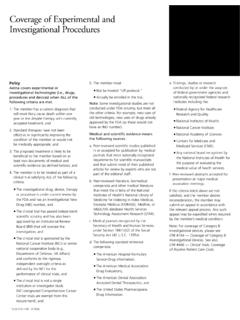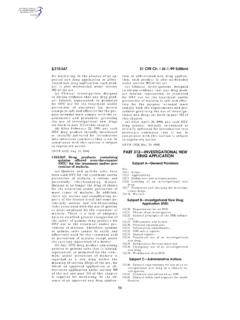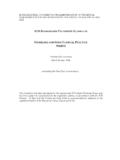Transcription of Guideline on strategies to identify and mitigate …
1 20 July 2017. EMEA/CHMP/SWP/28367/07 Rev. 1. Committee for Medicinal Products for Human Use (CHMP). Guideline on strategies to identify and mitigate risks for first-in-human and early clinical trials with investigational medicinal products Adopted by CHMP for release for consultation 10 November 2016. Start of public consultation 15 November 2016. End of consultation (deadline for comments) 28 February 2017. Adopted by CHMP 20 July 2017. Date of coming into effect 01 February 2018. Keywords First-in-human, phase I, early clinical trials, investigational medicinal product, risk mitigation, integrated protocols, multiple ascending dose, dose escalation. 30 Churchill Place Canary Wharf London E14 5EU United Kingdom Telephone +44 (0)20 3660 6000 Facsimile +44 (0)20 3660 5555. Send a question via our website An agency of the European Union European Medicines Agency, 2017. Reproduction is authorised provided the source is acknowledged. Guideline on strategies to identify and mitigate risks for first-in-human and early clinical trials with investigational medicinal products Table of contents Executive summary.
2 4. 1. Introduction (background) .. 4. 2. 5. 3. Legal basis .. 5. 4. General considerations .. 6. 5. Quality aspects .. 7. Determination of strength and potency .. 7. Qualification of the material used .. 7. Reliability of very small doses .. 7. 6. Non-clinical 7. Demonstration of relevance of the animal model .. 8. Nature of the target .. 9. Pharmacodynamics .. 9. Pharmaco- and toxicokinetics .. 10. Safety pharmacology .. 10. Toxicology .. 10. 7. Dosing selection for FIH and early clinical trials .. 11. General aspects .. 11. Starting dose for healthy volunteers .. 11. Starting Dose for 12. Dose escalation .. 13. Maximum exposure and dose .. 13. Moving from single to multiple dosing .. 14. Route of administration .. 14. 8. Planning and conduct of FIH and early clinical trials .. 14. General aspects .. 14. Protocol .. 15. Overall design .. 15. Integrated protocols .. 15. Choice of subjects .. 16. Subject assessments and interventions .. 16.
3 General considerations for all cohorts .. 17. Precautions to apply between treating subjects within a cohort .. 17. Guideline on strategies to identify and mitigate risks for first-in-human and early clinical trials with investigational medicinal products EMEA/CHMP/SWP/28367/07 Rev. 1 Page 2/22. Precautions to apply between cohorts and study parts .. 17. Data review for decision .. 18. Stopping rules .. 18. Monitoring and communication of adverse events/reactions .. 19. Documentation of sponsor and investigators responsibilities .. 20. Investigator site facilities and personnel .. 20. Abbreviations .. 22. Guideline on strategies to identify and mitigate risks for first-in-human and early clinical trials with investigational medicinal products EMEA/CHMP/SWP/28367/07 Rev. 1 Page 3/22. Executive summary This is the first revision of the Guideline on strategies to identify and mitigate risks for first-in-human clinical trials with investigational medicinal products'.
4 It extends the existing EU guidance to address first-in-human (FIH) and early phase clinical trials (CTs) with integrated protocols. The revision is intended to further assist stakeholders in the transition from non-clinical to early clinical development and in identifying factors influencing risk for new investigational medicinal products (IMPs). The document includes considerations on quality aspects, non-clinical and clinical testing strategies , study design and on conduct of FIH/early CTs. strategies for mitigating and managing risks are given, including principles on the calculation of the starting dose to be used in humans, the subsequent dose escalations, the criteria for maximum dose and the conduct of the trial inclusive of multiple parts. 1. Introduction (background). The purpose of FIH trials is to evaluate an investigational medicinal product (IMP) in humans for the first time, to study the human pharmacology, tolerability and safety of the IMP and to compare how effects seen in non-clinical studies translate into humans.
5 Traditionally FIH CTs were most associated with a single ascending dose (SAD) design, which was subsequently followed by a multiple ascending dose (MAD) CT. Since the publication of the original Guideline on strategies to identify and mitigate risks for first-in-human clinical trials with investigational medicinal products' in 2007, integration of the non-clinical data available before FIH administration and the pharmacokinetic (PK), pharmacodynamic (PD) and human safety data emerging during a trial has evolved. Consequently, the increasing practice is to perform FIH and early phase CTs with integrated protocols that combine a number of different study parts ( SAD, MAD and food effects). The safety and well-being of trial subjects (be they patients or healthy volunteers) should always be the priority and special consideration should be given to characterising risk and putting in place appropriate strategies to minimise risk. The Guideline aims to address as far as possible the important issues that may need consideration during the process of designing a set of studies in a clinical development programme.
6 As IMPs are widely different in their pharmacological features and intended use different parts of the Guideline may be important for some and inapplicable to others. In defining an appropriate development programme for an IMP, information on safety needs to be integrated from many sources and reviewed in an iterative process. strategies for development of a medicine and the experimental approaches used to assemble information relevant to the safety of CTs should always be science-based and decisions should be based on a rigorous interpretation of the totality of the available data. In the context of FIH/early CTs, data generated during a trial should also be used to inform the decision processes for the continuation of dosing. In those cases where an integrated protocol is used, the data generated during the trial should also be used to inform the decision to initiate a subsequent study part ( MAD or food-effect component), or to inform the selection of the doses of IMP to be evaluated for components being conducted sequentially or in overlapping fashion, respectively.
7 Whenever dose is mentioned in this Guideline , the expected exposure at that dose should always be taken into consideration (see sections , and ). Guideline on strategies to identify and mitigate risks for first-in-human and early clinical trials with investigational medicinal products EMEA/CHMP/SWP/28367/07 Rev. 1 Page 4/22. 2. Scope This Guideline covers FIH/early CTs including those which generate initial knowledge in humans on tolerability, safety, PK and PD. These trials may also include collection of data on food or drug interactions, different age groups or gender, proof of concept and relative bioavailability of different formulations. These trials are often undertaken in healthy volunteers but can also include patients. The Guideline applies to all new chemical and biological IMPs. While advanced therapy medicinal products (ATMPs) (as defined in Article 2(1) of Regulation 1394/2007 tested or used in accordance with Article 2(d) of Directive 2001/20/EC) are not within this scope, some principles of this Guideline are relevant on a case-by-case basis.
8 3. Legal basis This Guideline applies to relevant Clinical Trial Applications (CTAs) submitted in accordance with Directive 2001/20/EC, repealed by Regulation (EU) No 536/2014. It should be read in conjunction with Directive 2001/83/EC and all other pertinent elements outlined in current and future EU and ICH. guidelines and regulations, in particular: EudraLex - Volume 4 - Good Manufacturing Practice (GMP) guidelines . In particular, Annex 13: Manufacture of investigational Medicinal Products. Guideline on virus safety evaluation of biotechnological investigational medicinal products (EMEA/CHMP/BWP/398498/2005-corr.). Guideline on the requirements for quality documentation concerning biological investigational medicinal products in clinical trials (EMA/CHMP/BWP/534898/2008). Guideline on the requirements to the chemical and pharmaceutical quality documentation concerning investigational medicinal products in clinical trials (EMA/CHMP/QWP/834816/2015).
9 Guidance on non-clinical safety studies for the conduct of human clinical trials and marketing authorization for pharmaceuticals (ICH M3(R2)) and related Q&A document. Assessment and control of DNA reactive (mutagenic) impurities in pharmaceuticals to limit potential carcinogenic risk (ICH M7). Note for guidance on toxicokinetics: the assessment of systemic exposure in toxicity studies (ICH. S3A) and related Q&A document. Pharmacokinetics: Guidance for repeated dose tissue distribution studies (ICH S3B). Preclinical safety evaluation of biotechnology-derived pharmaceuticals (ICH S6(R1)). Safety pharmacology studies for human pharmaceuticals (ICH S7A). Non-clinical evaluation of the potential for delayed ventricular repolarization (QT interval prolongation) by human pharmaceuticals (ICH S7B). Non-clinical evaluation for anticancer pharmaceuticals (ICH S9) and related Q&A document. Directive 2010/63/EU of the European Parliament and of the Council on the protection of animals used for scientific purposes.
10 Guideline on strategies to identify and mitigate risks for first-in-human and early clinical trials with investigational medicinal products EMEA/CHMP/SWP/28367/07 Rev. 1 Page 5/22. Questions and Answers concerning the implementation of Directives 2004/9/EC and 2004/10/EC. on Good Laboratory Practice (GLP). EudraLex - Volume 10 - Clinical trials guidelines . Detailed guidelines on good clinical practice specific to advanced therapy medicinal products (ENTR/F/2/SF/dn D(2009) 35810). Guideline for good clinical practice (ICH E6(R2)). Clinical investigation of medicinal products in the paediatric population (ICH E11). Clinical evaluation of QT/QTc interval prolongation and proarrhythmic potential for non- antiarrhythmic drugs (ICH E14) and related Q&A document. Evaluation of anticancer medicinal products in man (CPMP/EWP/205/95 ). Guideline on clinical evaluation of new vaccines (EMEA/CHMP/VWP/164653/05). 4. General considerations The early clinical development of human medicinal products has an intrinsic element of uncertainty in relation to both the possible benefits and risks of a novel drug candidate.











![[ICH E2F] [EXAMPLE DSUR – PHASE III …](/cache/preview/1/3/5/f/e/1/c/f/thumb-135fe1cf2cdb82799c462ad0ea089c48.jpg)


